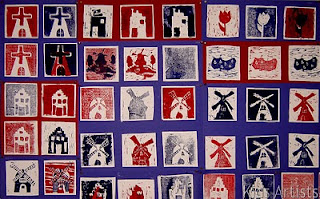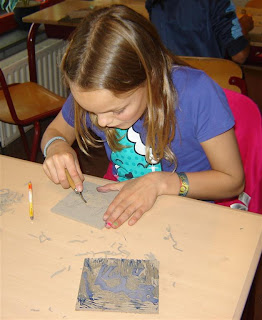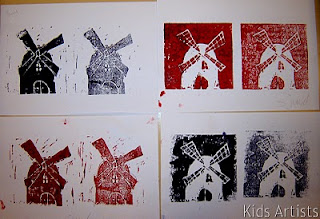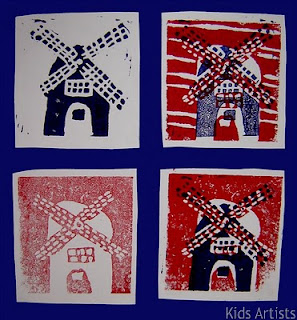- white drawing sheet A5 size
- piece of cardboard
- scissors
- oil pastels
- colour pencils
- watercolour paint
- jar with water
- brush
- coloured paper
- glue
- metallic gel pen or marker
dinsdag 8 februari 2011
Connected hearts
zaterdag 5 februari 2011
Patterned hearts like Jim Dine
- drawing sheet A5 size
- crayons
- liquid water colour
- brush
Fold the sheet of paper into quarters. Cut a heart out of a piece in the hearts: Trace this heart four times with a pencil. Draw patterns in the hearts with crayons: stripes, circles, zigzag lines etc. Draw different patterns around the hearts.
Paint the whole sheet with liquid watercolour. The crayon will resist the ink.
zaterdag 22 januari 2011
The man with the apple - like René Magritte (2)
- white drawing sheet A4 size
- aquarelle pencils
- jar with water
- brush
- fine black marker
In 1924 Magritte became friends with members of a surrealism group in Brussels: André Breton, Joan Miró and Salvador Dalí. These artists influence Magritte's work. In the end Magritte became famous with surrealistic paintings.
Magritte gave his paintings a realistic effect of surrealism. He painted simple objects, like a shoe, an apple, a pipe or a tree. Magritte took these things out of their ordinary environment and placed them in a special surrounding.
One of Magritte's most famous works is "La Trahison des Images" (The Treachery of Images). This is a very realistic painting from a pipe, with the text: Ceci n'est pas une pipe (This is not a pipe). The painting is not a pipe, but rather an image of a pipe. As Magritte himself commented: "The famous pipe. How people reproached me for it! And yet, could you stuff my pipe? No, it's just a representation, is it not? So if I had written on my picture 'This is a pipe,' I'd have been lying!" By putting us constantly on the wrong track, Magritte forces us to think about art. Magritte thought it the task of an artist to place reality in a different context.
Links: Magritte museum, Brussel See also the other lesson In the style of René Magritte (1) on this blog.
woensdag 19 januari 2011
Foreshortening fun
- white drawing sheet A4 size
- colour pencils
- coloured paper for background
Sneakers have beautiful soles; sometimes the soles better than the shoes themselves! This art lesson is about foreshortening, soles and the inside of hands. Foreshortening occurs when an object appears compressed when seen from a particular viewpoint, and the effect of perspective causes distortion. Foreshortening is a particularly effective artistic device, used to give the impression of three-dimensional volume and create drama in a picture.
Tell students a story about a scary monster. "Imagine a terrible scary monster approaching you. The monster is much bigger than you and is running fast. You are scared and your try to run backwards. This does not work and you fall. The monster leans over you and you try to ward off with your hands .... "
Students draw the bottoms of the shoes on about the half of the drawing sheet. Then they draw their hands, overlapping the tops of the shoes. They drew their head in between the hands, and add their body. The arms need to be drawn directly to the hands, and the legs have to be drawn to the bottoms of the shoes. Students draw details on the shoe bottoms, and lines on their hands.
Use colour pencils to colour the drawing. When finished, paste it on a coloured background.
All artworks are made by students of grade 5
zondag 16 januari 2011
Searching for the chameleon
You need:
- white drawing sheet A4 size
- oil pastels
- scissors
- small pieces of foam
- double sided tape
All artworks are made by students of grade 6
dinsdag 11 januari 2011
Colourful cows, like Peter Diem
You need:
- white painting sheet A3 size or a canvas
- acrylic paint
- brushes
- jar with water
- paper towels
Peter Diem (1945) is a Dutch painter. Diem, born from a Dutch father and a German mother, came in Amsterdam at the age of 3. He had a difficult childhood in which the people of Amsterdam showed they were not charmed by Germans so soon after the Second World War. After highschool Diem went to a school for graphic design to study graphic work. Through several European countries Diem landed in the 70's in the USA, where he married and had children. Halfway through the 90's he returned to the Netherlands and settled with his Diem Museum on the Prinsengracht Amsterdam.
Diem is inspired by the CoBrA Group ( a group of artists from Copenhagen, Brussels and Amsterdam - see also my lesson about CoBrA artist Corneille). His style is abstract and expressive. He brings the paint thick on the canvas, sometimes directly from the tube. With brush, knife and fingers the bright coloured paint is spread across the canvas. 'Diem paints like a tornado, he lives his art'. Themes in his work are flying cows, Napoleon, Africa and Ernest Hemingway.
Show artwork of Diem on the digital board. Pictures are to be found on Diem's website or use the Google picture viewer and look for Peter Diem. Discuss Diem's work:
- subject, Diem paints often cows

- use of bright colours
- simplicity of the image
- thick black contour lines
- no white spots anymore
- the cow is full screen
All artworks are made by students grade 5
donderdag 6 januari 2011
Artist Trading Cards
dinsdag 4 januari 2011
Stuffed animal
You need:
- white or coloured drawing sheet A4 size
- chalk pastel
- pencil
- hairspray
- stuffed animal
Ask students to take their favourite stuffed animal for this lesson. Let them choose their own drawing sheet. In my class students had to choose from grey, brown or white.
Tell students how to work with chalk pastel: you have to colour lightly and then smudge the chalk with your fingers. Don't produce to much powder, because you won't be able to smudge it away anymore. Vary with colours; you may use two colours and smudge them together. Tell students about light and show them lighter and darker parts of the stuffed animals. Use white chalk to lighten up parts of the stuffed animal, and black chalk to darken colours and make shadows.
Draw a horizon line and sketch your stuffed animal lightly with a pencil. Colour it with chalk pastel. Chalk pastel will emphasize the softness of the animal. Create a background and colour it completely. Use hairspray to fixate the chalk and paste the work on a coloured background.
All artworks are made by students of grade 6.
zaterdag 18 december 2010
Penguins and polar bears
Made by Jorine, grade 6
You need:
- white drawing sheet A4 size
- plastic wrap
- watercolour paint
- brush
- jar with water
- black waterproof marker
- white tempera paint
- orange marker
- glue
- coloured cardboard
- white pencil
Paint a part of the sheet with blue water paint. Use lots of water. While the paint is still wet, push plastic wrap on it to create floes and then leave the sheet to dry. Remove the wrap.
Use a waterproof black marker to draw several penguins. Colour the black parts and draw wings. Use white tempera to paint the bellies. Leave the work to dry and draw eyes and beaks.
Draw a polar bear on the ice. Trace the pencil lines with a fine black waterproof marker. Paint the bear with white tempera paint, including the black lines to make them a bit hazy. Paint the background with a mixture of white tempera and a little blue. In the example the mix is made of white tempera and the blue rinse water of the water paint.
Paste the work on a coloured background and draw ice crystals along the edges with a white pencil.
vrijdag 17 december 2010
Come on, let's make a snowman!
- blue construction paper A4 size
- oil pastels
- pencil
- white tempera
- brush
Students sketch a part of a snowman on blue paper. Sketch the hat and scarf and other items too. By choosing an incomplete snowman, students are forced to draw big. An additional advantage is that there remains some to imagine, because wwhat would your snowman look like if he filled the complete sheet?
Tell students that they begin to colour with white. This is to prevent the other colors will mix with white, and to be sure the white crayons will remain white! When the artwork is ready, outline everything with black oil pastel. Paint snowflakes around the snowman with white tempera paint and a sturdy brush.
Made by students of 10-11 years old
dinsdag 14 december 2010
Let it snow!
- black construction paper 20 by 20 cm
- white tempera paint
- saucer
- paper towel
- fine markers in black and white
- metallic gel pens
I found the idea of printed snowmen in one of Usborne's activity books. With music lines, I made my own lesson of it.
Draw curved music lines with a white or silver pen on the black sheet. Put a piece of paper towel on a saucer so it can serve as a stamp pad. Drip some tempera paint the paper towel. Use your thumb to stamp the bodies of the snowmen. Add a fingerprint for a head.
When the paint is dry, you can add eyes, nose, mouth, arms, buttons etc. Use gel pens and markers. Draw some music notes on the lines and write the lyrics of a winter song belof the lines.
maandag 13 december 2010
Christmas stamp


- brown paper bag
- markers
- correction fluid
maandag 6 december 2010
Christmas tree in strips
Made by a student of 11 years old
You need:- white drawing sheet A4 size
- black construction paper A4 size
- tempera paint
- brush
- advertising leaflet with Christmas decorations or aluminum foil or scrapbooking paper
- glue
- glitter stars
- small piece of brown paper
Tear a trunk out of brown paper. Tear strips of the painted sheet that are about the same width. Place the paper strips on a black sheet in the form of a Christmas tree; the strips have to become slightly shorter. Put the trunk below the bottom strip and paste it. Paste the green strips, so that the trunk disappears partly under the lower strip.
Cut balls and a peak out of aluminium foil or advertising leaflets. You can also use scrapbooking paper. Paste balls and peak on the tree. Cut squares and rectangles (presents!) of coloured paper and paste them under the tree. Paste glitter stars around the tree.woensdag 1 december 2010
Christmas gift paper bag
- brown paper bag
- markers
- scissors
- ruler
- glue
- pattern gift bag
- piece of rope of 25 cm
- punch
Pattern: click and print.
Print the pattern. Let students copy the pattern on a paper bag. Cut it. Make a Christmas drawing on one or both sides of the bag and colour it with markers. The snow in the example is made with correction fluid. Or make a drawing on a white sheet and paste this one on the bag. Fold the lines. Paste the bag, starting with the side and finishing with the bottom. Use a punch to make holes in the bag. Pull a rope through the holes to get two rods and tie it.
zaterdag 27 november 2010
Dutch December skyline
You need:
- black construction paper 20 by 20 cm
- chalk pastel
- coloured pencils
- white sheet A4 size for stencil
donderdag 25 november 2010
I love Holland
Made by students of grade 6
You need:
- two pieces of linoleum of 12 by 12 cm
- white drawing paper
- lino knives
- block printing ink in red and blue
- flat piece of glass
- linoleum roller
- lino press
- cardboard in red and blue
- scissors
- glue
2 pieces of linoleum, 2 colours, 8 prints
Finally use one or more of those prints to make a two colour print. This has to be done by inking piece 1 red and printing it on a blue print of piece 2. See picture below. Let students choose their best prints and let them decide how many prints they want to use for their final artwork. Cut the prints with 1 cm white aound them. Make a composition on blue or red cardboard and paste the prints with 1 cm between them.Final composition I love Holland, by Malou, grade 6
zondag 21 november 2010
Transport yourself
- piece of linoleum of 16 by 12 cm
- white paper towel from a towel dispenser
- mat
- block printing ink
- flat piece of glass
- linoleum roller
- lino press
Draw a mean of transportation on a piece of linoleum and cut it out. Shake the bottle of blockprint carefully to be sure oil will mix with the rest. Drip the paint on the glass and roll it out with the lino roller. Make several prints of your work on textured towel paper. Choose the best one to be your artwork.
zondag 14 november 2010
Printed leaves
You need:
- black construction paper A4 size
- flat dried autumn leaves
- white tempera and another cool colour
- brush
- colour pencils
- piece of sponge
I found this project on Artsonia. Ask students to take some autumn leaves for this lesson. The leaves should be dried flat, for example in a phone book.
Paint the veined side of a leaf with thick white tempera. Press the leaf on black paper; use a clean sheet to cover the leaf and press on it with flat hand. Do this with several leaves. Then pick an additional cool colour to blend with the leftover white paint and sponge paint the background. Be sure to leave a little black around each leaf for contrast. Add some autumn colour to each leaf using coloured pencils.woensdag 10 november 2010
Treasure map
Made by a student of 11 years old
You need:- white drawing sheet A4 size
- strong brewed tea
- wide, flat brush
- colour pencils
- candle
Drawing a treasure map is always exciting! A treasure map is a map that leads to a treasure or secret place. Little drawings tell you what you say on your way, and the road is often indicated by a dotted line. Treasure maps look often crumpled or discoloured, as if they have been well hidden. Students know treasure maps from books and comics. If not, show them some treasure maps on the digital board.
To make the treasure map look old and yellowed, the drawing sheet has to be painted with strong brewed tea. Do this at an earlier time so that the sheets have dried well before the drawing starts.
If the sheet is dry, a map that will lead the seeker to the treasure has to be drawn. Students have to make clarifying little drawings on the map and then colour everything with colour pencils. The treasur e map has to contain a compass rose.
e map has to contain a compass rose.
A job that is too dangerous for the children themselves to do, but that gives a nice weathered appearance: burning away the edges. Do this, being a teacher, yourself!
To give the treasure map something extra, students can create their own cryptography. This cryptography has to be rolled up and pasted on the map.
Also nice: seal the treasure map using drops candlewax. Press a coin in it, just before the fat has solidified!
zondag 7 november 2010
Fall things
- white drawing sheet 30 by 20 cm
- pencil
- ruler
- crayons
- liquid watercolour
- brush
- jar with water
- coloured paper for background
- glue
Made by a student of 11 years old












































.jpg)
.jpg)
